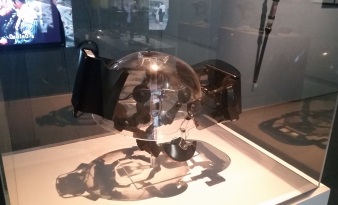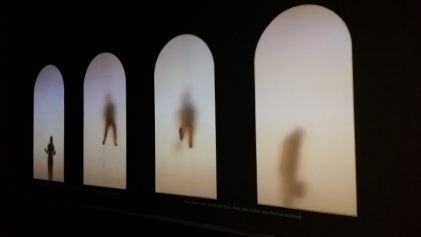FACT Gallery 1, Wood Street, until 16th October, free.
As you may be aware, government support for the arts is not exactly strong at the moment. Not only have cuts stifled funding for existing projects, arts education has been an easy target for councils and schools needing to save money from somewhere. This indifference comes, I think, from the fact that the arts don’t produce the sort of explicit financial rewards that governments are looking for. Science = industry. Maths = bankers. Arts = ideas. Freedom of thought. The realization that ever increasing growth is perhaps not the road to happiness.
Unfortunately, we live in a materialist culture, in the sense of materialism being “obsessed with tangible stuff”. Money is stuff. Clothes are stuff. Arts aren’t stuff, unless somebody is paying a lot of money for them. Until society gets over the need for things to have physical value, I see no end to this I’m afraid.
But until 16th October, if I need to convince somebody about the social value of art, I’m going to suggest that they start in Gallery 1 of FACT.

Guidance for how to use the Homeless Person Vehicle
Krzysztof Wodiczko is an artist who, growing up in Soviet-controlled Poland, must have understood the importance of artistic expression. This show is something of a mini-retrospective of pieces which fit into the ‘Flashback’ Episode and focuses on creating dialogue around tough social subjects, the type which most people would be happy to ignore.
On the evidence here, Wodiczko likes his pieces to attract public attention. Take for example his Homeless Vehicle Project. It demands your attention from the centre of the room, and would certainly make you look twice if it was being rolled along the streets of New York by a homeless person. Which is exactly what happened in the late 80s.
Although the Homeless Vehicle Project was designed in collaboration with homeless people to meet their needs, it wasn’t intended to be a solution to the homeless crisis – how could it be? It’s not really a home! But by drawing the attention of the general public to the issue, it makes people think “what is the answer then?”.

War Veteran Helmet, 2015
The most recent work here, 2015’s War Veteran Helmet, packs even more of a punch. War can have devastating long-term impacts on people, but it’s difficult for those of us without direct experience of war conditions to understand. Wodiczko has worked on several projects recently – including in a 2009 FACT commission – which aim to make these experiences more widely understood.
The War Veteran Helmet is designed to recreate aspects of the experiences of war and trauma. In a video a veteran explains how the helmet reduces or alters the senses to passers-by in a shopping centre. Many are visibly nervous about trying the helmet on for themselves and who can blame them, who would want to inflict these experiences on themselves? The helmet therefore begins to raise many and varied questions about the morality of war. You can also see that the helmet is, for these veterans, a prism through which to talk about their feelings which, as with the homeless people above, it would be easier to ignore.

Guests, 2009
Every piece here raises a question about our interaction with the rest of society and two works here, Alien Staff and Guests, focus on immigrants’ experiences. In a time where hate crime is dramatically on the rise, this is a conversation which needs to be had. People often have strong reactions either way to the subject of immigration but what I like about Guests in particular is that it couldn’t be accused of forcing a liberal opinion on its audience. It’s a very objective artwork – indeed, the blurred windows create a separation between the viewer and the storytellers. All it asks of you is to watch and listen. Listen to the experiences of others and maybe try to understand why they have come. Watch as they go about their lives, so that you can make a more informed judgement on their impact on society.
I left this gallery feeling more moved than I have done by anything I’ve seen in the Biennial so far, with a heightened sense of compassion for people’s different situations. I’m one person and I don’t necessarily know how the issues raised in this room can be solved. But getting one more person to start thinking about the solution is a step in the right direction.
